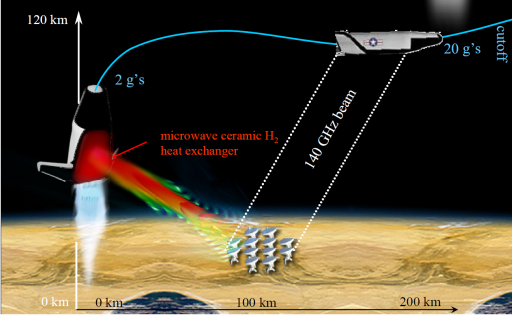NASA Ames’ Worden reveals DARPA-funded ‘Hundred Year Starship’ program
October 18, 2010 by Amara D. Angelica
Video of Pete Worden and Peter Schwartz. Audio podcast of the full 19-minute conversation also available.
NASA Ames Director Simon “Pete” Worden revealed Saturday that NASA Ames has “just started a project with DARPA called the Hundred Year Starship,” with $1 million funding from DARPA and $100K from NASA.
“You heard it here,” said Worden at “Long Conversation,” a Long Now Foundation event in San Francisco. “We also hope to inveigle some billionaires to form a Hundred Year Starship fund,” Dr. Worden added. “I absolutely will be on board.” (No further details on this are available from NASA at this time.)
“The human space program is now really aimed at settling other worlds,” he explained. “Twenty years ago you had to whisper that in dark bars and get fired.” (Worden was in fact fired by President George W. Bush, he also revealed.)
To Boldly Go: A One-Way Human Mission to Mars
Paul Davies, a physicist and cosmologist from Arizona State University, and Dirk Schulze-Makuch, a Washington State University associate professor, argue for a one-way manned mission to Mars. … They reason that a manned one-way mission would not only cut the costs by several fold, but also mark the beginning of long-term human colonization of the planet…. read more
New propulsion ideas
Worden also mentioned some nearer-term ideas that NASA is exploring (and that are not necessarily related to the Starship program). One new propulsion concept is electric propulsion, said Worden. “Anybody that watches the [Star Trek] Enterprise, you know you don’t see huge plumes of fire. Within a few years we will see the first true prototype of a spaceship that will take us between worlds.”
Worden said NASA is also funding a new program to develop microwave thermal propulsion for getting to orbit. “The idea is if you can beam power to the spaceship, so you don’t have to carry all the fuel; and then you use that energy from a laser or microwave power to heat a propellant; it gets you a pretty big factor of improvement. I think that’s one way of getting off the world.”
The principal investigator of this program is Dr. Kevin L.G. Parkin, who invented the technology and described it in his PhD thesis. He is assisted by Creon Levit and David Murakami. Caltech grad student Dmitriy Tseliakhovich has also formed a company called Escape Dynamics LLC to commercialize the microwave thermal propulsion project. (Tseliakhovich’s team project at Singularity University this past summer grew out of Parkin’s work.)

“The microwave thermal thruster using beamed propulsion is an excellent idea,” said Dr. Narayanan M. Komerath, a professor at Georgia Tech College of Engineering and a NASA Institute of Advanced Concepts Fellow. “[Kevin Parkin] picks the 140 GHz window, which apparently offers strong advantages in absorption by the materials that he uses in the propulsion system.”
Space settlements and electric planes
But Worden warned that in settling on other worlds, we need to be cautious. “How do you live in another world? I don’t have the slightest idea,” he said. “If you’re a conservative, you worry about it killing us; if you’re a liberal, you worry about us killing it. I think things like synthetic biology have lot of potential for that. I think rather than make an environment on Mars like Earth, why don’t we modify life … including the human genome … so it’s better suited to [Mars]?”
Worden also thinks we should go to the moons of Mars first, where we can do extensive telerobotics exploration of the planet. “I think we’ll be on the moons of Mars by 2030 or so. Larry [Page] asked me a couple weeks ago how much it would cost to send people one way to Mars and I told him $10 billion, and his response was, ‘Can you get it down to 1 or 2 billion?’ So now we’re starting to get a little argument over the price.”
Meanwhile, back on Earth, Worden says NASA Ames is exploring another radical new concept: a heavy-lift airship that could carry hundreds of tons. “I think that could revolutionize air transport, because it becomes very cheap and still goes 100 knots. The idea is that you could easily go to Hawaii overnight, for example… with a lot less fuel.
“The long-term answer [to the rapidly accelerating growth of travel in the developing world and the increase in greenhouse gas] is a “Tesla in the air” — using high-density batteries powered off ground-based solar grids, so your airliner stays plugged in overnight, and it’s got an electrical engine rather than a chemical engine. I think within ten years we’ll have small-scale business-level ones, and within 20, they’ll be the airliners.
“If we don’t, I think aviation’s through.”
This revision corrects information about the microwave thermal thruster program and makes it clear that the Hundred Year Starship is not necessarily related to the other ideas mentioned by Worden. Video and audio podcast added 10/28/2010. Full disclosure: KurzweilAI is affiliated with Singularity University.
